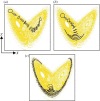Uncertainty in weather and climate prediction
- PMID: 22042896
- PMCID: PMC3270390
- DOI: 10.1098/rsta.2011.0161
Uncertainty in weather and climate prediction
Abstract
Following Lorenz's seminal work on chaos theory in the 1960s, probabilistic approaches to prediction have come to dominate the science of weather and climate forecasting. This paper gives a perspective on Lorenz's work and how it has influenced the ways in which we seek to represent uncertainty in forecasts on all lead times from hours to decades. It looks at how model uncertainty has been represented in probabilistic prediction systems and considers the challenges posed by a changing climate. Finally, the paper considers how the uncertainty in projections of climate change can be addressed to deliver more reliable and confident assessments that support decision-making on adaptation and mitigation.
Figures












References
-
- Lorenz E. N. The predictability of a flow which possesses many scales of motion. Tellus. 1969;21:19.
-
- Lorenz E. N.1963Deterministic nonperiodic flow J. Atmos. Sci. 20130–141.10.1175/1520-0469(1963)020<0130:DNF>2.0.CO;2 (doi:10.1175/1520-0469(1963)020<0130:DNF>2.0.CO;2) - DOI - DOI
-
- Buizza R., Houtekamer P. L., Pellerin G., Toth Z., Zhu Y., Wei M.2005A comparison of the ECMWF, MSC, and NCEP Global Ensemble Prediction Systems Mon. Wea. Rev. 51076–1097.10.1175/MWR2905.1 (doi:10.1175/MWR2905.1) - DOI - DOI
-
- Molteni F., Palmer T. N.1993Predictability and finite-time instability of the northern winter circulation Q. J. R. Meteorol. Soc. 119269–298.10.1002/qj.49711951004 (doi:10.1002/qj.49711951004) - DOI - DOI
-
- Gelaro R., Buizza R., Palmer T. N., Klinker E.1998Sensitivity analysis of forecast errors and the construction of optimal perturbations using singular vectors J. Atmos. Sci. 551012–1037.10.1175/1520-0469(1998)055<1012:SAOFEA>2.0.CO;2 (doi:10.1175/1520-0469(1998)055<1012:SAOFEA>2.0.CO;2) - DOI - DOI
LinkOut - more resources
Full Text Sources
